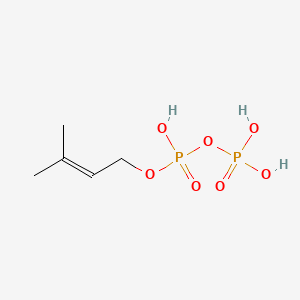| Ma Y et al. |
Genome-wide identification and characterization of novel genes involved in terpenoid biosynthesis in Salvia miltiorrhiza. |
2012 |
J. Exp. Bot. |
pmid:22291132
|
| Span I et al. |
Crystal structures of mutant IspH proteins reveal a rotation of the substrate's hydroxymethyl group during catalysis. |
2012 |
J. Mol. Biol. |
pmid:22137895
|
| Yu X et al. |
Biochemical characterization of indole prenyltransferases: filling the last gap of prenylation positions by a 5-dimethylallyltryptophan synthase from Aspergillus clavatus. |
2012 |
J. Biol. Chem. |
pmid:22123822
|
| Fu X et al. |
Plastid structure and carotenogenic gene expression in red- and white-fleshed loquat (Eriobotrya japonica) fruits. |
2012 |
J. Exp. Bot. |
pmid:21994170
|
| Bang S et al. |
Nociceptive and pro-inflammatory effects of dimethylallyl pyrophosphate via TRPV4 activation. |
2012 |
Br. J. Pharmacol. |
pmid:22300296
|
| Qian Q et al. |
Mechanistic studies on CymD: a tryptophan reverse N-prenyltransferase. |
2012 |
Biochemistry |
pmid:22935004
|
| Behr M et al. |
Remodeling of cytokinin metabolism at infection sites of Colletotrichum graminicola on maize leaves. |
2012 |
Mol. Plant Microbe Interact. |
pmid:22746825
|
| Testa CA and Johnson LJ |
A whole-cell phenotypic screening platform for identifying methylerythritol phosphate pathway-selective inhibitors as novel antibacterial agents. |
2012 |
Antimicrob. Agents Chemother. |
pmid:22777049
|
| Lu XM et al. |
Map-based cloning of zb7 encoding an IPP and DMAPP synthase in the MEP pathway of maize. |
2012 |
Mol Plant |
pmid:22498772
|
| Nakatani H et al. |
Substrate-induced change in the quaternary structure of type 2 isopentenyl diphosphate isomerase from Sulfolobus shibatae. |
2012 |
J. Bacteriol. |
pmid:22505674
|
| Song AA et al. |
Functional expression of an orchid fragrance gene in Lactococcus lactis. |
2012 |
Int J Mol Sci |
pmid:22408409
|
| Kuzuyama T and Seto H |
Two distinct pathways for essential metabolic precursors for isoprenoid biosynthesis. |
2012 |
Proc. Jpn. Acad., Ser. B, Phys. Biol. Sci. |
pmid:22450534
|
| Trowbridge AM et al. |
Contribution of various carbon sources toward isoprene biosynthesis in poplar leaves mediated by altered atmospheric CO2 concentrations. |
2012 |
PLoS ONE |
pmid:22384238
|
| Yang ZB et al. |
Physiological and molecular analysis of the interaction between aluminium toxicity and drought stress in common bean (Phaseolus vulgaris). |
2012 |
J. Exp. Bot. |
pmid:22371077
|
| Fowler DW et al. |
Mycobacteria activate γδ T-cell anti-tumour responses via cytokines from type 1 myeloid dendritic cells: a mechanism of action for cancer immunotherapy. |
2012 |
Cancer Immunol. Immunother. |
pmid:22002242
|
| Türsen U |
Pathophysiology of the Behçet's Disease. |
2012 |
Patholog Res Int |
pmid:21977335
|
| Hussain MS et al. |
Current approaches toward production of secondary plant metabolites. |
2012 |
J Pharm Bioallied Sci |
pmid:22368394
|
| Aros D et al. |
Volatile emissions of scented Alstroemeria genotypes are dominated by terpenes, and a myrcene synthase gene is highly expressed in scented Alstroemeria flowers. |
2012 |
J. Exp. Bot. |
pmid:22268153
|
| Thabet I et al. |
Characterization and subcellular localization of geranylgeranyl diphosphate synthase from Catharanthus roseus. |
2012 |
Mol. Biol. Rep. |
pmid:21706164
|
| Jonnalagadda V et al. |
Isopentenyl diphosphate isomerase catalyzed reactions in D2O: product release limits the rate of this sluggish enzyme-catalyzed reaction. |
2012 |
J. Am. Chem. Soc. |
pmid:22471428
|
